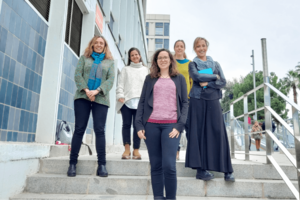Researchers generate a stem cell-based model to study an ultra-rare disease that causes childhood parkinsonism
Researchers from the Institut de Recerca Sant Joan de Déu (IRSJD), the Bellvitge Biomedical Research Institute (IDIBELL), Sant Pau Research Institute (IIB Sant Pau) and the UB have presented a new model based on human stem cells of an ultra-rare genetic disease that affects children called Tyrosine Hydroxylase Deficiency (THD).
THD causes a significant decrease of dopamine in the brain, one of the most relevant neurotransmitters in the central nervous system, and usually affects pediatric patients, causing childhood parkinsonism. Some patients improve with treatment, but others are refractory and continue with severe motility symptoms and intellectual disability.
The model published in the journal EMBO Molecular Medicine, which reproduces the pathological characteristics of the disease, was created from patients' skin cells reprogrammed into pluripotent stem cells, capable of transforming into any cell type, and which subsequently were differentiated into neurons.
"The model provides a very useful tool to investigate the pathogenic mechanisms of THD, as well as for new therapies development that improve patient management. Also, It can help to implement personalized therapies since not all patients respond to treatment", explains Dr. Antonella Consiglio, group leader at IDIBELL, the School of Medicine and Health Sciences and the Institute of Biomedicine of the University of Barcelona (IBUB), professor and researcher at ICREA Academy, and one of the project leaders.
Dr. Alba Tristán Noguero, first author of the work and postdoctoral researcher at the Sant Pau Research Institute (IIB Sant Pau) and at the Departament of Genetics, Microbiology and Statistics at the Faculty of Biology of UB, explains that as it happens at a physiological level, neurons differentiated from patient stem cells have low dopamine levels. In addition, these neurons show morphological defects not detected with other experimental approaches.
The model also reproduces the patients' response to treatment. Dopamine only reverses the symptoms of patients with mild THD; on the other hand, severe patients do not respond to treatment and finally develop cognitive impairments.
One of the most hopeful observations of the work is that, in the model that reproduces the most severe condition of THD, the early administration of dopamine, when the neurons are still differentiating, prevents the disease defects. This result suggests that treatment could work in the most severe patients if it applies during brain development.
"This is the first THD model capable of differentially reproducing the characteristics of mild and severe patients, and which also reproduces their different response to treatment," says Dr. Àngels García Cazorla, pediatic neurology leader the Metabolic Diseases Unit of the SJD Barcelona Children's Hospital and group leader at the IRSJD, member of the School of Medicine and Health Sciences of the UB and the Center for Biomedical Research in Rare Diseases Network (CIBERER), and co-leader of the project.
In this work, it also participates Irene Fernández-Carasa, Carlos Calatayud, Arianna Colini Baldeschi, Meritxell Pons-Espinal and Ángel Raya from IDIBELL and the UB. Cristina Bermejo-Casadesús, Mercè Pineda, Rafael Artuch of the IRSJD. Leticia Campa, Francisco Artigas, Analia Bortolozzi from IDIBAPS. Rosario Domingo-Jiménez and Salvador Ibáñez from the Virgen de la Arrixaca Hospital and the Virgen de la Arrixaca Biosanitary Research Institute of Murcia (IMIB).
The work is included in the project to study childhood parkinsonism financed by the Fundació La Marató TV3 led by Dr. Consiglio and Dr. Garcia-Carzorla. The work also received support from the European Research Council (ERC), the Ministry of Economy and Competitiveness (MINECO), the Ministry of Science and Innovation (MCIN), the Next Generation Funds (EU), the Carlos III Health Institute (ISCIII), the European Regional Development Fund (FEDER), and the State Research Agency (AEI).
Reference

This study were published in the journal EMBO Molecular Medicine, and the project were financed by the Fundació La Marató de TV.
